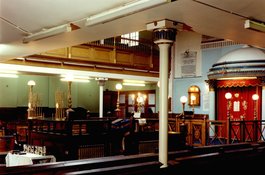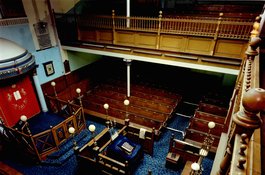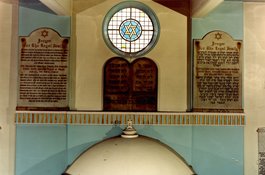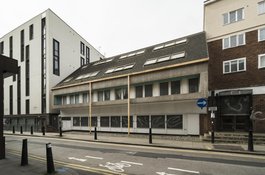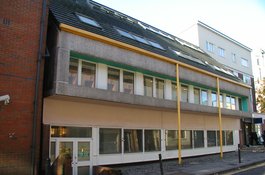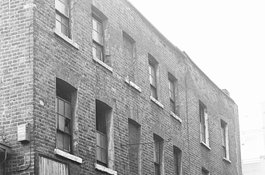Great Garden Street Synagogue in the Nineties
Contributed by Ted on July 7, 2017
There was a lovely, small congregation here in the early nineties. I first went in 1990. I didn't live in the area till much later. I was a stranger from North London, and they made me very welcome. I was then around 30, and the youngest man there by about 20 years, and below the average age by a heck of a lot more.
It was already a sad but proud relic of a vibrant community. All the East End synagogues were in similar position and slowly amalgamating. Stepney had just closed and a couple of their old boys came. It still had its own rabbi then. Just. But the nearby lunch club was about to close, the last East End kosher food venue. There was a plaque up to the chap who had been synagogue president for about 30 years. It broke his heart to see the place decline. As I say, they were a proud lot, I was told the place was the cathedral of the East End synagogues.
There was a strong move of Jews to the suburbs to north west London and to Essex even from before the war. Those that remained by the nineties tended to be older, poorer and less likely to be family men. It is a lasting regret that I didn’t explore the area when I first came to London in 1984, I’m sure there would have been much more to it.
Caretaker
Contributed by tony2 on June 27, 2017
I grew up opposite the synagogue and flats during the 60s/70s...in Evelyn House (the other side of Old Montague Street)...predominantly a Jewish block at the time...always think of the caretaker of the synagogue, old Jock, when I see photos...he lived in the attached flats behind......He used to shoo away us local non-Jewish kids when we were snooping round the back door of the kitchen area...or near any entrances....
We were used to begging for lutkes (or luktas as we called them... fried potato snacks) from the kitchen at the back door of Bloom's kitchen...occasionally scoring half a dozen to share between us, other times chased away by the chef!
Back at the synagogue..old Jock was a good old stick, even though he kept us away from the enticing smells that wafted from the kitchen.....He was a good friend of my nan and always had a smile and a good word when I wasn't trespassing.
He used to have nieces that came on hols during the summer holiday that I always used to play with...so long ago now that I can't recall their names....
So even though I never saw the inside of Great Garden St (always be Greatorex St to me!) I have fond memories of some of its occupants....
Still have a Whitechapel Heart!
